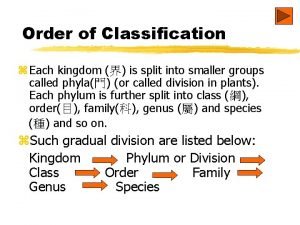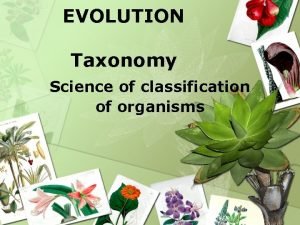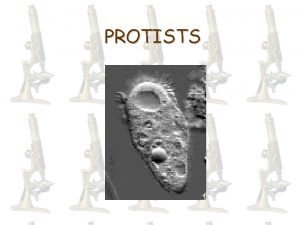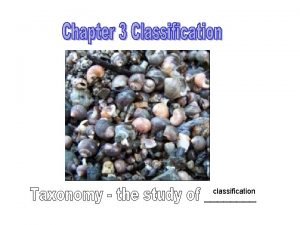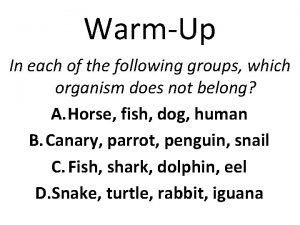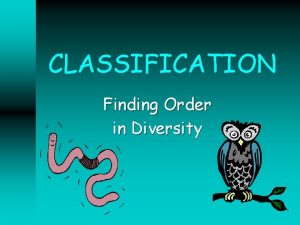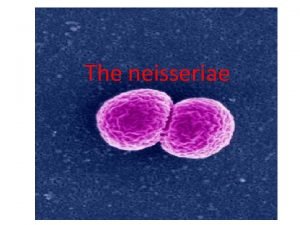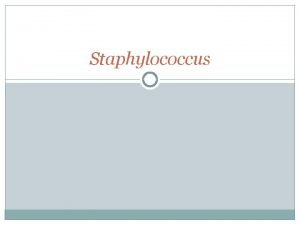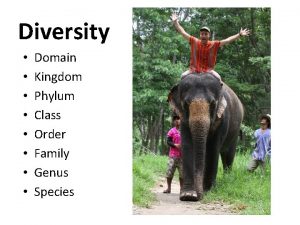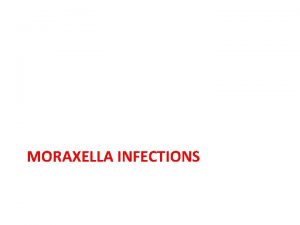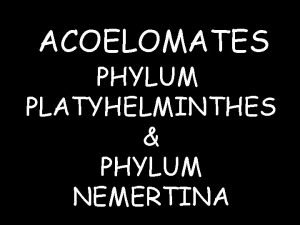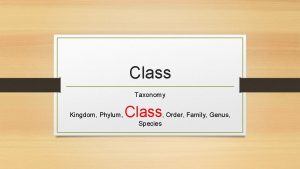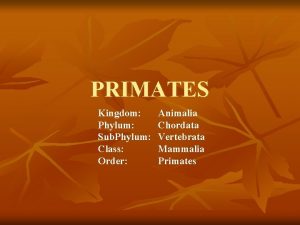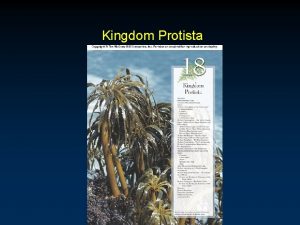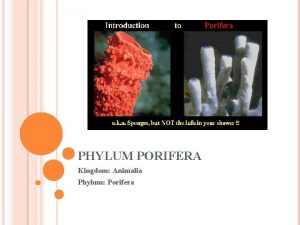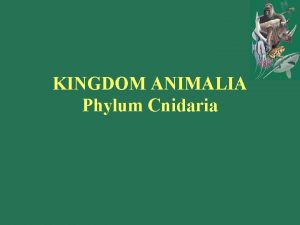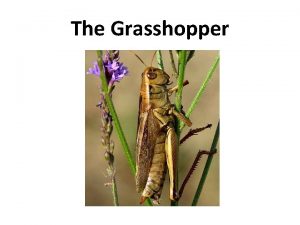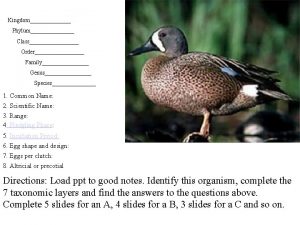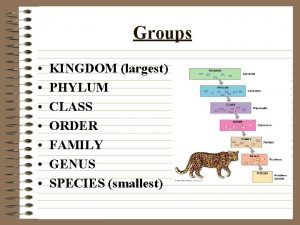Classification Levels DOMAIN KINGDOM PHYLUM CLASS ORDER FAMILY

















- Slides: 17

Classification Levels DOMAIN KINGDOM PHYLUM CLASS ORDER FAMILY GENUS SPECIES

BUDDING - asexual

CONJUGATION - sexual

Classification levels – 3 Domains/6 Kingdoms �Domain: Archaea Kingdom: Archaebacteria -prokaryotes; unicellular with a cell wall - can be autotrophs or heterotrophs -most live in extreme/hostile environments; open ocean - reproduce asexually (binary fission) or sexually (conjugation) *binary fission = cell divides *conjugation = transfer of DNA through a tube

Classification levels – 3 Domains/6 Kingdoms �Domain: Bacteria Kingdom: Eubacteria -prokaryotes; unicellular with a cell wall - can be autotrophs or heterotrophs - some bacteria cause disease; many are beneficial - live almost everywhere - reproduce asexually (binary fission) or sexually (conjugation)

Classification levels – 3 Domains/6 Kingdoms �Domain Eukarya Kingdoms: Protista, Fungi, Plantae, Animalia

The Six Kingdoms

The Six Kingdoms: Archaebacteria Eubacteria Protist Fungi Plant Animal

How are organisms placed into their kingdoms? ØCell type, complex or simple ØTheir ability to make food or not ØThe number of cells in their body

d e e n e w s §Heterotroph-organism cannot make its own o g t foodhin w o t n §Autotroph-organism can make its own food 5 n k a o y t f o i §Multicellular-organism contains more than t s s n i a one cell cl m s §Unicellular-organism iis made of only one s n a m cell g o r d o g n §Cell wall i k §No cell wall §Prokaryote-cells do not have a nucleus §Eukaryote-cells contain nucleus

Eukaryote Some have no cell walls. Cell walls; some have chloroplast Most unicellular; some multicellular Autotroph or heterotroph “Junk-drawer kingdom”; live in water or damp environments Reproduce asexually(fission, budding) or sexually(conjugation)

Eukaryote Cell walls Most multicellular; some unicellular Heterotroph Water or damp environments Reproduce asexually(budding) or sexually(spores)

. Eukaryote Cell walls Multicellular Autotroph live in water and on land reproduce asexually(plantlets; runners) and sexually (pollination)

Eukaryote No cell walls Multicellular Heterotroph live in water and on land reproduce asexually(budding) but mostly sexually(egg/sperm)

Why and how do scientists classify organisms? � to make sense and order of the millions of living things on Earth; to make organisms easier to study!! � groups organisms based on characteristics they share � “taxonomy” – the science of classifying and naming � a scientific name consists of a “Genus” name followed by the “species” name common name: scientific name: cat ------------Felis domesticus asian elephant-------Elephas maximus T-rex------------Tyrannosaurus rex

�“dichotomus keys” – a tool/ special guide using paired statements to help identify an organism; means divided into 2 parts example: 1. a. This mammal flies; hand forms wing b. this mammal does not fly little brown bat go to step 2 2. a. this mammal has no hair on its tail b. this mammal has hair on its tail go to step 3 go to step 4 (and so on………)

a growing system………. . �new organisms are STILL being discovered and classified today!
 Domain kingdom phylum class order family genus species
Domain kingdom phylum class order family genus species Kingdom phylum class order
Kingdom phylum class order Domain kingdom phylum
Domain kingdom phylum Kingdom family genus species
Kingdom family genus species Kingdom phylum class order family genus and species
Kingdom phylum class order family genus and species 8 levels of classification
8 levels of classification Class order family genus species
Class order family genus species Do you italicize scientific names
Do you italicize scientific names Euglena domain
Euglena domain Plant kingdom phylum class order
Plant kingdom phylum class order Horse kingdom phylum class order
Horse kingdom phylum class order Kingdom phylum class order of humans
Kingdom phylum class order of humans Classification of humans
Classification of humans Kingdom phylum class order
Kingdom phylum class order Kingdom phylum class order
Kingdom phylum class order Bacteria phylum
Bacteria phylum Bacteria kingdom phylum class order
Bacteria kingdom phylum class order Platypus phylum
Platypus phylum




